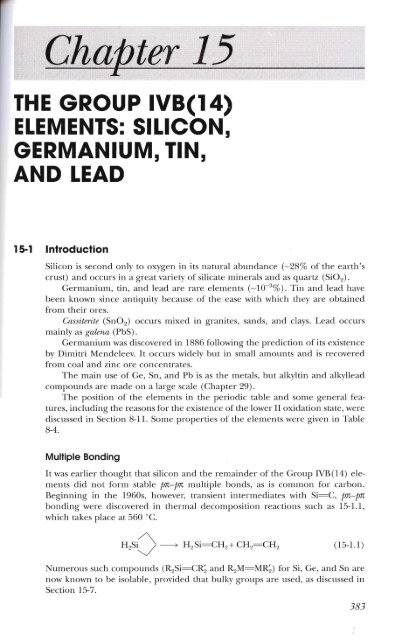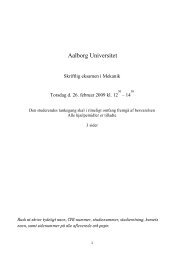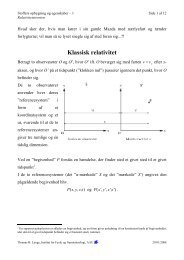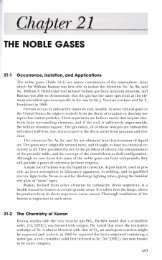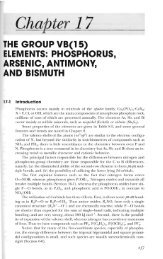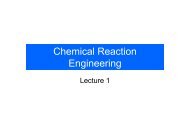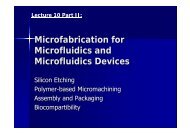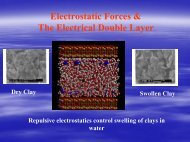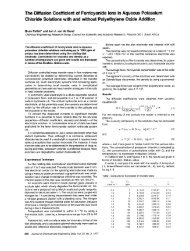Chapter 15 THE GROUP IVB(14) ELEMENTS
Chapter 15 THE GROUP IVB(14) ELEMENTS
Chapter 15 THE GROUP IVB(14) ELEMENTS
- No tags were found...
Create successful ePaper yourself
Turn your PDF publications into a flip-book with our unique Google optimized e-Paper software.
<strong>15</strong>- 1 Introduction 3853. The disilyl ethers, (RsSi)20, all have large angles at oxygen (<strong>14</strong>0-180°),and both electronic and steric explanations have been suggested. Electronically,overlap between filled oxygen JJTt orbitals and empty silicon d1t orbitals would improvewith increasing Si-O-Si angles, and might be most effective for a linearSi-O-Si group. There may also be very strong steric factors favoring more linearstructures, especially for large R groups. For instance, the angle at oxygen is180° for (PhsSi)20.4. Silanols such as (CHs)sSiOH are stronger protonic acids than their carbonanalogs, and form stronger hydrogen bonds. This is due to stabilization ofthe conjugate base anion by O(jJTt) ~ Si(d1t) bond formation. A similar stabilizationof the conjugate base anion can be invoked to explain the order of acidities(M = Si > Ge > C) in the series RsMC02H.StereochemistryThe stereochemistry of silicon compounds and the lower members of Group<strong>IVB</strong>(l4) depend on the oxidation state. Also, unlike carbon, certain compoundsof these elements have five, six, seven, and eight or higher coordination.Compounds having oxidation state IV are listed in Table <strong>15</strong>-1. All of the elementsform tetrahedral compounds, some of which are chiral, for example,GeH (CHs)C 6 H 5 (a-napthyl). Since valence shell expansion by use of outer d orbitalscan occur, giving hybridizations (such as dsps and d 2 sPS) , five- and six-coordinatecompounds are common, as shown in Table <strong>15</strong>-1. Pentacoordination isfound mainly in(a) Anions such as MX;; and MRnX~_5' which are usually trigonal bipyramidal,and are stabilized in the solid state by large cations.(b) Adducts of donor ligands with halides or substituted halides of the elements,such as L~MX4.(c) For Sn, polymeric compounds RsSnX, where X acts as a bridge in thesolid state structure.Octahedral coordination is common for all of the elements, although for ionsand adducts, the preference for five or six coordination depends on delicate energybalances, and cannot be predicted.Table <strong>15</strong>-1 Coordination Number and Geometry of Tetravalent Compoundsof the Group <strong>IVB</strong>(l4) ElementsCoordinationNumber Geometry Examples3 Trigonal (ABs) (C 6 H 5 )sSi+4 Tetrahedral (AB4) Si02, SiCI4, GeH4, Pb(CHs)45 Trigonal bipyramidal (ABs) (CHg)gSnCI(py), SnCrs,SiFs,RSiF 45 Square pyramidal (AB 5 ) [XSi(02C6H4)2]6 Octahedral (AB 6 ) SiF~-, [Si(acac)s]+, [Si(ox)g]2-,Ge02, PbCl~-, trans-GeCI 4 (pYhSn(S2CNEt2)47 Pentagonal bipyramid Ph2Sn(NOg)2(OPPhg)8 Dodecahedral Sn(NOs)4, Pb(02CCHS)4
386 <strong>Chapter</strong> <strong>15</strong> / The Group <strong>IVB</strong>(<strong>14</strong>) ElementsTable <strong>15</strong>-2 Coordination Number and Geometry of Divalent Compounds of theGroup <strong>IVB</strong>(<strong>14</strong>) ElementsCoordinationNumber Geometry Examples2 Angular (AB2E) Ge(N-t-Bu2)2' Pb(C 6 Hsh3 Pyramidal (AB3E) SnC12'2 H 20, SnCl;, Pb(SC 6 Hs);4 "Seesaw" (AB 4 E) Pb" in Pb30 4Sn(S2CNR2)25 Square pyramidal (ABsE) SnO (blue-black form), PbO6 Octahedral PbS (NaCl type)GeI2 (Ca1 2 type)7 Complex (18-C-6)SnCl+9, 10 Complex Pb (NOs) 2(semicarbazone)Pb(02CCH3)2'3 H20Compounds having oxidation state II are listed in Table <strong>15</strong>-2. In many of thecompounds ofSn Il , and to a lesser extent Cell and Pb lI , the lone pair of electronson the metal atom has important structural and stereochemical consequences.First, the structures are such that the lone pairs, unlike the so-called "inert pairs,"appear to occupy a bond position. Thus the SnCI; ion is pyramidal with a lonepair, as in NH3. According to the ABxE y scheme, which was discussed in <strong>Chapter</strong>3, we would therefore consider this Sn atom to fall into the AB3E classification.The lone pair not only has structural consequences, but chemical ones as well;SnCI; can act as a donor toward transition metals, as in the complex[Pt ll (SnCI 3 )s]3-. Consider also SnCI 2 '2H 2 0, which contains a pyramidalSnCl 2 0H 2 molecule; the second water molecule is not coordinated, and is readilylost at 80°C. Other Sn ll compounds, such as SnCl 2 and SnS, accomplish threecoordination in the solid by use of a bridging group between the metal atoms.The Sn 2 F; ion consists of two SnF3 groups sharing a fluorine atom.In Ce S F12, the Cell atoms fall into the ABsE classification, being square pyramidalwith the lone pair occupying the sixth position. The same is true of SnO(the blue-black form) and of PbO, in which there are MOsE metal atoms.<strong>15</strong>·2 Isolation and Properties of the ElementsSilicon is obtained in the ordinary commercial form by reduction of Si0 2 withcarbon or CaC 2 in an electric furnace. Similarly, Ge is prepared by reduction ofGe02 with Cor H 2 • Silicon and Ge are used as semiconductors, especially in transistors.For this purpose, exceedingly high purity (
<strong>15</strong>-4 Chlorides: MCI 4 387Tin and lead are obtained by reduction of the oxide or sulfide with carbon.The metals can be dissolved in acid and deposited electrolytically to effect furtherpurification.Silicon is ordinarily rather unreactive. It is attacked by halogens giving tetrahalides,and by alkalis giving solutions of silicates. Silicon is not attacked by acidsexcept hydrofluoric; presumably the stability of [SiF6] 2- provides the drivingforce here.Germanium is somewhat more reactive than silicon and dissolves in concentratedH 2 S0 4 and HN0 3 . Tin and lead dissolve in several acids and arerapidly attacked by halogens. These elements are slowly attacked by cold alkali,and rapidly by hot, to form stannates and plumbites. Lead often appears to bemore noble and unreactive than would be indicated by its standard potential of-0.13 V. This low reactivity can be attributed to a high overvoltage for hydrogenand also, in some instances, to insoluble surface coatings. Thus lead is not dissolvedby dilute H 2 S0 4 and concentrated HCl.<strong>15</strong>-3 Hydrides: MH 4These are colorless gases. Only monosilane (SiH 4 ) is of any importance. Thisspontaneously flammable gas is prepared by the action of LiAlH 4 on Si0 2 at<strong>15</strong>0-170 °C or by reduction of SiCl 4 with LiAlH 4 in an ether. Although stable towater and dilute acids, rapid base hydrolysis gives hydrated Si0 2 and H 2 •Substituted silanes with organic groups are of great importance, as are someclosely related tin compounds (<strong>Chapter</strong> 29). The most important reaction ofcompounds with Si-H bonds, such as HSiCl 3 or HSi(CH 3 h is the Speier or hydrosilationreaction of alkenes.(<strong>15</strong>-3.1)This reaction, which employs chloroplatinic acid as a catalyst, is commerciallyimportant for the synthesis of precursors to silicones.<strong>15</strong>-4 Chlorides: MCI 4Chlorination of the hot Group <strong>IVB</strong> (<strong>14</strong>) elements gives colorless liquids (MCI 4 ),except PbCI 4 , which is yellow. The compound PbCl 4 may also be prepared byReaction <strong>15</strong>-4.1.(<strong>15</strong>-4.1)The tetrachlorides are eventually hydrolyzed by water to hydrous oxides, but limitedhydrolysis may give oxochlorides. In aqueous HCI, the tetrachlorides of Snand Pb give chloroanions, [MCI 6 f-.The compound GeCl 4 differs from SiCl 4 in that the former can be distilledand separated from concentrated HCI, whereas silicon tetrachloride is immediatelyhydrolyzed by water.The principal uses of SiCI 4 and GeCI 4 are in the synthesis of pure Si and Ge.Additional uses of SiCI 4 and SnCl 4 are in syntheses of organometallic compounds(<strong>Chapter</strong> 29).
388 <strong>Chapter</strong> <strong>15</strong> I The Group <strong>IVB</strong>(<strong>14</strong>) Elements<strong>15</strong>·5 Oxygen CompoundsSilicaPure Si02 occurs in two forms, quartz and cristobalite. The Si is always tetrahedrallybound to four oxygen atoms but the bonds have considerable ionic character.In cristobalite the silicon atoms are placed as are the carbon atoms in diamond,with the oxygen atoms midway between each pair. In quartz, there arehelices so that enantiomorphic crystals occur, and these may be easily recognizedand separated mechanically.Quartz and cristobalite can be interconverted when heated. These processesare slow because the breaking and re-forming of bonds is required and the activationenergy is high. However, the rates of conversion are profoundly affectedby the presence of impurities, or by the introduction of alkali metal oxides.Slow cooling of molten Si02 or heating any solid form to the softening temperaturegives an amorphous material that is glassy in appearance and is indeeda glass in the general sense, that is, a material with no long-range order but, instead,a disordered array of polymeric chains, sheets, or three-dimensional units.Silica is relatively unreactive towards C12, H 2, acids, and most metals at 25°Cor even at slightly elevated temperatures but is attacked by F2, aqueous HF, alkalihydroxides, and fused carbonates.Aqueous HF gives solutions containing fluorosilicates (e.g., [SiF 6 ] 2-). The silicateshave been discussed in Section 5-4. The fusion of excess alkali carbonateswith Si02 at about 1300 °C gives water-soluble products commercially sold as asyrupy liquid that has many uses. Aqueous sodium silicate solutions appear tocontain the ion [Si02(OHhf- but, depending on the pH and concentration,polymerized species are also present. In weathering of rocks and soils, "silicicacid," Si(OH)4' is released in addition to [Al(H20h(OH)]2+ and[Al(H20)4(OH)2]+, and it appears that soluble silica can thereby reduce the Allevels, through formation of aluminosilicates (<strong>Chapter</strong> 5).The basicity of the dioxides increases, with Si02 being purely acidic, Ge02less so, Sn02 amphoteric, and Pb02 somewhat more basic. When Sn02 is madeat high temperatures or by dissolving Sn in hot concentrated nitric acid, it is, likePb02, remarkably inert to attack.Only lead forms a stable oxide containing both Pb ll and Pb TV , namely, Pb 3 0 4 ,which is a bright red powder known commercially as red lead. It is made by heatingPbO and Pb02 together at 250°C. Although it behaves chemically as a mixtureofPbO and Pb02, the crystal contains Pb TV 0 6 octahedra linked in chains bysharing opposite edges. The chains are linked by Pb Il atoms each bound to three° atoms.There are no true hydroxides and the products of hydrolysis of the hydridesor halides, and the like, are best regarded as hydrous oxides.Among the most interesting and commercially valuable of silicon-oxygencompounds are the aluminosilicates, which have been mentioned earlier(Section 5-4).<strong>15</strong>·6 Complex CompoundsMost of the complex species contain halide ions or donor ligands that are 0, ,S, or P compounds.
<strong>15</strong>-6 Complex Compounds 389Anionic ComplexesSilicon forms only fluoroanions, normally [SiF 6 ]2-, whose high formation constantaccounts for the incomplete hydrolysis of SiF4 in water, according toReaction <strong>15</strong>-6.1.(<strong>15</strong>-6.1 )The ion is usually made by dissolving Si0 2 in aqueous HF and is stable even inbasic solution. Under selected conditions and with cations of the right size, the[SiFsr ion can be isolated, for example,Si0 2+ HF(aq) + R N+Cl- CHsOH) [R N] [SiF ]4 4 s (<strong>15</strong>-6.2)By contrast with [SiF 6 ] 2-, the [GeF 6]2- and [SnF 6]2- ions are hydrolyzed by bases;[PbF 6 ]2- ion is hydrolyzed even by water.Although Si does not, the other elements give chloroanions, and all the elementsform oxalato ions [M(OX)S]2-.Cationic ComplexesThe most important are those of chelating uninegative oxygen ligands, such asthe acetylacetonates. An example is [Ge(acac)s]+.The tetrahalides act as Lewis acids; SnCl4 is a good Friedel-Crafts catalyst.The adducts are 1:1 or 1:2 but it is not always clear in the absence of X-ray evidencewhether they are neutral, that is, MX4L2, or whether they are salts, for example,[MX 2 L2] X 2 . Some of the best defined are the pyridine adducts, forexample, trans-(py) 2SiC<strong>14</strong>.Alkoxides, Carboxylates, and Oxo SaltsAll four elements form alkoxides. Those of silicon [e.g., Si(OC2Hs)4] are themost important; the surface of glass or silica can also be alkoxylated. Alkoxidesare normally obtained by the standard method, solvolysis of chlorides, as in Eq.<strong>15</strong>-6.3.MCl4 + 4 ROH + 4 amine ----7 M(OR)4 + 4 amine·HCI (<strong>15</strong>-6.3)Silicon alkoxides are hydrolyzed by water, eventually to hydrous silica. Of the carboxylates,lead tetraacetate is the most important, as it is used in organic chemistryas a strong but selective oxidizing agent. It is made by dissolving Pbs0 4 in hotglacial acetic acid or by electrolytic oxidation of Pb Il in acetic acid. In oxidationsthe attacking species is probably Pb(OOCCHs);, which is isoelectronic with thesimilar oxidant, TI(OOCCHsh, but this is not always so, and some oxidations arefree radical in nature. The trifluoroacetate is a white solid, which will oxidizeeven heptane to give the ROOCCFs species, whence the alcohol ROH is obtainedby hydrolysis; benzene similarly gives phenol.Tin(IV) sulfate, Sn(S04h·2 H 20, can be crystallized from solutions obtainedby oxidation of Sn Il sulfate; it is extensively hydrolyzed in water.Tin(IV) nitrate is a colorless volatile solid made by interaction of N20 S andSnCI4; it contains bidentate NO; groups giving dodecahedral coordination. Thecompound reacts with organic matter.
390 <strong>Chapter</strong> <strong>15</strong> / The Group <strong>IVB</strong>(l4) Elements<strong>15</strong>·7 The Divalent StateSiliconDivalent silicon species are thermodynamically unstable under normal conditions.However, several species, notably SiO and SiF2, have been identified inhigh temperature reactions and trapped by chilling to liquid nitrogen temperatures.Thus at about 1100 °c and low pressures, the following reaction goes inabout 99.5% yield:(<strong>15</strong>-7.1)Silicon difluoride (SiF2) is stable for a few minutes at 10- 4 cm pressure; themolecule is angular and diamagnetic. When the frozen compound warms, itgives fluorosilanes up to Si 16 F34'GermaniumGermanium dihalides are stable. Germanium difluoride (GeF2) is a white crystallinesolid obtained by the action of anhydrous HF on Ge at 200°C; it is a fluorinebridged polymer with approximately tbp coordination of Ge. Germaniumdichloride (GeCI2) gives salts of the GeClsion similar to those ofSn noted in thenext subsection.TinThe most important compounds are SnF2and SnCI2, which are obtained by heatingSn with gaseous HF or HC\. The fluoride is sparingly soluble in water and isused in fluoride-containing toothpastes. Water hydrolyzes SnCI2 to a basic chloride,but from dilute acid solutions SnCI2'2H20 can be crystallized. Both halidesdissolve in solutions containing an excess of halide ion, thusSnF2 + F- = SnF s pK""1 (<strong>15</strong>-7.2)SnCl 2 + CI- = SnCl s pK"" 2 (<strong>15</strong>-7.3)In aqueous fluoride solutions SnFs is the major species, but the ions SnF+ andSn2F; can be detected.The halides dissolve in donor solvents such as acetone, pyridine, or DMSO,to give pyramidal adducts, for example, SnCI20C(CH3)2'The very air-sensitive tin(II) ion (Sn 2 +) occurs in acid perchlorate solutions,which may be obtained by reduction of copper(II) perchlorate as in Reaction<strong>15</strong>-7.4.Cu(CI04h + Sn/Hg = Cu + Sn 2 ++ 2 CIO:;; (<strong>15</strong>-7.4)Hydrolysis gives [Sn3(OH)4f+, with SnOH+ and [Sn2(OH)2J 2 + in minoramounts.log K= -6.77 (<strong>15</strong>-7.5)The trimeric, probably cyclic, ion appears to provide the nucleus of several basic
<strong>15</strong>-7 The Divalent State 391tin (II) salts obtained from aqueous solutions at fairly low pH. Thus the nitrateappears to be SnS(OH)4(NOs)2 and the sulfate, SnS(OH)20S04' All Sn Il solutionsare readily oxidized by oxygen and, unless stringently protected from air,normally contain some Sn TY • The chloride solutions are often used as mild reducingagents.SnCl~- + 2 e- = SnCl; + 3 Cl- EO = ca. 0.0 V (1 MHCl, 4 MCn (<strong>15</strong>-7.6)LeadOf the four elements, only lead has a well-defined low-valent cationic chemistry.The lead(II) ion (Pb 2 +) is partially hydrolyzed in water.log K"" -7.9 (<strong>15</strong>-7.7)In concentrated solutions and on addition of base, polymeric ions that containthree, four, and six Pb atoms are formed. The crystalline "basic" salthas the cluster structure in Fig. <strong>15</strong>-2. The ° atom lies at the center of the middletetrahedron, while the OH groups lie on the faces of the outer tetrahedra.Most lead salts are only sparingly soluble in water and some (e.g., PbS04 orPbCr0 4 ) are insoluble. The common soluble salts are Pb(NOs)2 andPb(C02CHs)2'2 H 20, which is incompletely ionized in water. The halides are alwaysanhydrous and in solution they form complex species PbX+, PbX;, and soon, except for the fluoride where only PbF+ occurs.Silenes and Other Organo CompoundsAlthough for many of the elements, discussion of organo chemistry has been reservedfor later chapters, it is now appropriate to mention the recent developmentsin divalent organo chemistry for silicon, germanium, and tin. Compoundsof stoichiometry GeR2 or SnR2, which were known for a long time, proved to becyclogermanes or stannanes such as (Me2Sn)6 (where Me = CHs), or variousother polymers with MIl_MIl bonds. Also, the silicon compounds made by thereduction of R2SiCl2 with Li or Na/K in THF, where R is not a bulky ligand, areFigure <strong>15</strong>-2 The three face-sharing tetrahedraofPb atoms in the Pb 6 0(OH):+ cluster.
392 <strong>Chapter</strong> <strong>15</strong> I The Group <strong>IVB</strong>(<strong>14</strong>) Elementscyclic pOlymers. These compounds are often similar to hydrocarbons, but differin having large (-1<strong>15</strong>°) Si-Si-Si angles.However, when the alkyl or aryl R groups are very bulky, monomers (MR 2 )or dimers (R 2 M=MR 2 ) can be isolated. The simplest silene (Me 2 Si) can be obtainedonly in the gas phase or in solution by thermal decomposition of thecyclic hexamer, as in Reaction <strong>15</strong>-7.8.The first isolable silene, the yellow tetramesityl disilene, Structure <strong>15</strong>-1""" ... m. .\~mes L\\\S\= S\-------------ill?mes<strong>15</strong>-1where mesH'C~)CH,(<strong>15</strong>-7.8)HsCcan be made photochemically according to Reaction <strong>15</strong>-7.9.(<strong>15</strong>-7.9)This compound is an air sensitive, but thermally stable solid, with a slightly benttrans structure, the angle 8 being 18°. In this respect, this silene differs from typicalalkenes, which are planar. The Si=Si bond (2.16 A..) is about 9% shorterthan a Si-Si single bond. Many other disilenes can be made by the reduction ofR 2 SiCl 2 with Li, and some compounds have sufficiently strong double bonds topermit the existence of cis and trans isomers. There are similar R 2 Si=CR 2 compoundscontaining Si=C bonds. A good example is Me 2 Si=C(SiMe 3 ) (SiMet-Bu2 ), where the C 2 Si=CSi 2 skeleton is planar, with a C=Si bond distance of1.702 A. Finally, compounds with Si=N, Si=P, and Si=O bonds are known, forexample, t-Bu2Si=NSi-t-Bu3'The germenes, which can be made by the action of Grignard reagents onGeCl 2 'dioxane in ether, and stannenes, are less stable than silenes. Distortionsfrom planar geometry are larger than is found among the silenes. Tin and leadform highly colored monomers or dimers, but in Sn 2 R 4 the Sn-Sn distance is2.76 A.., a value closer to that of a Sn-Sn single bond.<strong>15</strong>-8 Summary of Group Trends for theElements of Group <strong>IVB</strong>(<strong>14</strong>)Using the list of periodic chemical properties listed in Section 8-11, as well asproperties mentioned in <strong>Chapter</strong>s <strong>14</strong> and <strong>15</strong>, we can now summarize the periodictrends in the properties of the elements of Group <strong>IVB</strong> (1 4) .
<strong>15</strong>-8 Summary of Group Trends for the Elements of Group <strong>IVB</strong>(<strong>14</strong>) 3931. Carbon(a) Is completely nonmetallic.(b) Has a strong tendency for catenation among its compounds.(c) Forms molecular (covalent) substances almost exclusively (carbidesexcepted) .(d) Obeys the octet rule, the maximum covalence being four.(e) Forms divalent (lower valent) compounds that are unstable (as in reactiveintermediates), or that exist as such only as a formality (e.g.,CO).(f) Forms hydrides that are stable, molecular substances that are difficultto hydrolyze, but oxidize readily.(g) Forms stable, molecular halides that are not readily oxidized or hydrolyzed.(h) Forms oxides (CO and CO 2 ) that are acidic anhydrides.(i) Forms multiple bonds of the jJTt-jJTt variety, which can be conjugated.2. Silicon(a) Is a nonmetal.(b) Displays little or no tendency for catenation among its compounds.(c) Forms mostly covalent substances, as well as polyatomic ions andoxoanions containing covalent bonds.(d) Readily undergoes coordination number expansion to a maximumcovalence of six, namely, SiF; and SiF~-.(e) Forms divalent (lower valent) compounds only rarely, an examplebeing the unstable SiF 2 .(f) Forms hydrides that are reactive and unstable, an example beingSiH 4 , which is readily hydrolyzed.(g) Forms molecular halides that are readily hydrolyzed.(h) Forms an oxide (Si0 2 ) that is an acidic, covalent-network substance.(i) Forms strong, but unconjugated multiple bonds of the jJTt-drt variety,especially to ° and N.3. Germanium, Tin, and Lead(a) Are increasingly metallic on descent of the group, Ge being most likeSi.(b) Display little catenation, since in general bond strength decreases ondescending the group.(c) Form both covalent and ionic substances.(d) Form compounds with a variety of coordination numbers, six or eightbeing common.(e) Form divalent (lower valent) compounds that are increasingly stableupon descending the group.(f) Do not form any important covalent hydrides.(g) Form both high-valent (MX 4 ) and low-valent (MX 2 ) molecularhalides, which are readily hydrolyzed and undergo coordinationnumber expansion to produce, for instance, SnCI~- or PbCI~-.(h) Display increasingly metallic character on descent of the group, as
394 <strong>Chapter</strong> <strong>15</strong> I The Group <strong>IVB</strong>(<strong>14</strong>) Elementsdemonstrated by the following. Whereas Si0 2 is acidic and Sn0 2 isamphoteric, Pb0 2 iy purely a basic anhydride.(i) Form multiple bonds of the pn-drr variety, but less effectively on descentof the group.STUDY GUIDEStudy QuestionsA. Review1. Why is CO2 a gas and Si02 a giant molecule?2. Explain what is meant by dn-tm bonding.3. Why does tin form divalent inorganic compounds more easily than silicon?4. How is super pure Ce made from Ce02?5. Write balanced equations for the synthesis of SiH 4 and for its hydrolysis by aqueousKOH.6. Why is CCl 4 unreactive to H20, whereas SiCl 4 is rapidly hydrolyzed?7. Why is SiF 4 incompletely hydrolyzed by water?8. Explain the nature of zeolites and of molecular sieves.9. Why does silicon have much less tendency to form bonds to itself than does carbon?10. How is lead tetraacetate made?11. What is red lead?12. What is the nature of Sn Il in aqueous chloride solution?B. Additional Exercises1. Explain why HsSiNCS has a linear SiNCS group, whereas in HsCNCS the CNC groupis angular.2. Why are silanols, such as (CHshSiOH, stronger acids than their carbon analogs?3. List the various types of geometries among the compounds of the tetravalent Croup<strong>IVB</strong>(l4) elements and give examples. For each example, give the structural classificationfor the Croup <strong>IVB</strong>(<strong>14</strong>) atom, according to the ABxE yscheme of <strong>Chapter</strong> 3.4. What methods could one use to determine the nature of 1:1 and 1:2 adducts ofSnC1 4with neutral donors?5. Why can Sn lI compounds, such as SnCI;, act as donors (ligands) to transition metals?6. The single-bond energies for the elements of the first and second short periods followthe trends C > Si; N < P; ° < S; F < Cl. Why is the first pair in the list apparentlyanomalous?7. Predict the relative n-bond strength between Band N in the two compoundsbis(trimethylsilyl)aminoborane and bis (lerl-butyl) aminoborane. Explain your answerin terms of the n orbitals that are involved.8. Draw the n-bond system that is responsible for the planarity of trisilylamine.9. Draw the Lewis diagrams and discuss the geometries of SnCI2, SnCI;, and[Pt(SnCIs)s]S-.10. Balance the equation for the reaction of SiCl 4 with LiAIH 4 •11. Use valence shell electron-pair repulsion (VSEPR) theory to compare the bond anglesin the pyramidal ions SnF;, SnCI;, and CeCl;;.
Study Guide 39512. Review the material of Section 8-11 plus the material of this chapter, and summarizethe facts concerning the low-valent state for the elements of Group <strong>IVB</strong>(<strong>14</strong>), citingspecific compounds as examples to illustrate each point.13. Compare the reactivities of the divalent chlorides (GeCI 2 , SnCI 2 , and PbCI 2 ) withchlorine, and use this information to arrive at the correct order of stabilities of thedivalent state for these elements.<strong>14</strong>. Diagram the apparent extent of the rc-bonding systems in HsSiNCO and inHgGeNCO, taking into consideration the geometries of the two.<strong>15</strong>. Explain the planarity of disilylamine using an orbital overlap approach.16. Offer an explanation for the relative extent of N-to-M rc bonding in HsSi CO versusHgGe CO.17. The compound SnCI2(C 2 Hs)2 crystallizes as long needles, in which there areSn-CI-Sn bridges in one plane and ethyl groups in coordination positions perpendicularto that plane. The effective coordination number of Sn in the solid is six,but there are two Sn-CI distances in the structure. Propose a solid state structure.18. Choose the correct answer from among the following possibilities:(a) The most stable low-valent halide:GeCI 2 SnCl2 PbCl 2(b) A nonexistent halide:SnCl 4 PbCl 4 PbI 4(c) A purely acidic oxide:Pb0 2 Sn02 Si0 2(d) Forms an oxoacid on treatment with HNOs:P 4 Sb 4 Bi(e) The most stable hydride:NHg PHg AsHs([) The substance that is coordinatively saturated:CCl 4 SiCI 4 PbCl 4(g) The substance that is not coordinatively saturated:SnF;; CH 4 PClt;19. Explain how the following reaction demonstrates the acidity of Si0 2 :20. List and explain three ways in which the chemistry of carbon differs from that of theother members of the group.21. Give balanced equations for each of the following:(a) Production of Ge from the oxide.(b) Oxidation of Si by chlorine.(c) Dissolution of SnCl 2 in pyridine.(d) Hydrolysis of GeCI 4 .(e) Hydrolysis of Sn 2 + solutions.(f) Hydrolysis of SiF 4 ,22. Why does the tendency towards catenation decrease on descent of Group <strong>IVB</strong> (<strong>14</strong>)?Illustrate your answer with some examples.23. Suggest a synthesis, starting from elemental silicon and fluorine, of SiF~-.24. What is the main product on reaction of lead with chlorine, PbCl 4 , PbCI2, or PbOCl?25. Suggest a synthesis of lithium bis(dimethylsilyl)amide.26. Sketch the structures of SnCI 2 , SnCl;;, SnF 4 , and SnF;;.
396 <strong>Chapter</strong> <strong>15</strong> I The Group <strong>IVB</strong>( <strong>14</strong>) ElementsC. Questions from the Literature of Inorganic Chemistry1. Let the paper by R. H. Nielson and R. L. Wells, Inorg. Chern., 1977, 16,7-11, serve asa basis for the following questions:(a) What typical values for B-N rotational barriers does one expect for mono-, bis-,and tris-aminoboranes?(b) Why should studies of rotational barriers in these aminoboranes indicate the relativeextent of 11: bonding between boron and an .N-u-imethylsilyl, an .N-trimethylgermyl,and an .N-trimethylstannyl substituent?(c) Both a steric and a competitive 11:-bonding argument can be given to explain thetrends reported here. Elaborate.2. Consider the paper by D. Kummer and T. Seshadri, Angew. Chern. Int. Ed. Eng., 1975,<strong>14</strong>, 699-700.(a) Determine the oxidation state of Si and draw the Lewis diagram for each of theSi-containing compounds mentioned in this article.(b) Predict the geometry for each of these compounds.3. Compare and contrast the structure of and the bonding in two different classes ofSn N compounds as presented in(a) R2SnX 2. W. Alcock andJ. F. Sawyer,] Chern. Soc., Dalton Trans., 1977,1090-1095.(b) SnCI4(PR 3 )2G. G. Mather, G. M. McLaughlin, and A. Pidcock, J Chem. Soc., Dalton Trans.,1973, 1823-1827.4. Consider the compounds M[CH(Me3Si)2h where M = Ge, Sn, or Pb, as described byJ. D. Cotton, P.J. Davidson, and M. F. Lappert, J Chern. Soc., Dalton Trans., 1976,2275-2285.(a) Draw the Lewis diagram of these substances.(b) Explain (and give an example of) each of the four types of reactions mentionedfor these substances.5. Look up the structure of PbO (Acta Crystallogr., 1961, <strong>14</strong>, 1304) and describe thegeometry at lead. What structural role does the "lone pair" play?6. The structure of the [K(l8-C-6)]+ salt of [(t-Bu)3C6H2-SiF4r was reported by S. E.Johnson, R. O. Day, and R. R. Holmes, Inorg. Chern., 1989, 28, 3182. What unusualbond angles are there in this anion, and what is the apparent cause?7. Read the first report on the structure of two stable disilenes by M.J. Fink, M.J.Michalczyk, K.J. Haller, R. West, and J. Michl, "X-ray Structure of Two Disilenes,"Organornetallics, 1984,3,793-800.(a) Which of these two disilenes has a structure most like an alkene?(b) What two principle deviations from planarity are noted for Compound 1a?(c) What explanations do the authors give for the pyramidalization at Si inCompound 1a?(d) Why do these distortions from planarity not occur for Compound 1b?SUPPLEMENTARY READINGBreck, D. W., Molecular Sieves, Wiley, New York, 1973.Burger, H. and Eugen, R., 'The Chemistry of Lower-Valent Silicon," Topics in CurrentChemistry, o. 5, Springer-Verlag, Berlin, 1974.


